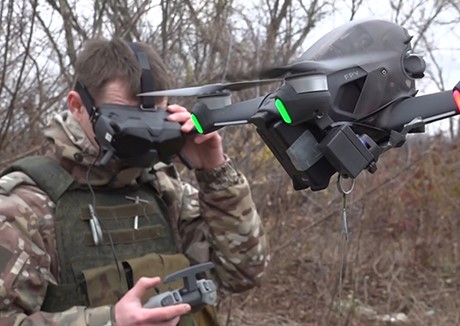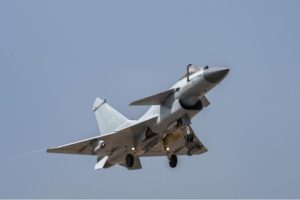
Former Wagner Troops Integrated Into Chechen Unit Fighting in Ukraine
By Lionel Beehner

State Border Guard Service of Ukraine
“A platoon dubbed Kamerton (Tuning Fork) consisting of fighters from the now-defunct Wagner Private Military Company (PMC), who had been incorporated into the ranks of the Akhmat special forces group, has carried out a successful assault on a Ukrainian-occupied elevated point.”
On 12 December 2023, a platoon of former fighters from the disbanded Wagner Group carried out an operation in Ukraine-controlled Bakhmut. The operation, a successful assault on the town, marked one of the few times that the official Russian news agency, TASS, has mentioned the Wagner Group after its failed mutiny in 2023 and the death of its mercurial leader, Yevgeny Prigozhin.
While the article does not provide significant detail about the operation itself, it confirms that remnants of Wagner are still actively fighting in Ukraine. The platoon, called Kamerton (or “Tuning Fork”), is under the command of the Akhmat Special Forces, a 12,000-strong Chechen special forces unit that is part of the Russian National Guard.[i] Roughly 1,200 Akhmat fighters are estimated to be fighting in Ukraine, though their poor discipline has drawn criticisms (they have been dubbed the “TikTok Army” for their social media posts).[ii]
The second excerpted article from TASS, published on 1 December 2023, provides more detail about Kamerton’s operational capability. It describes the platoon as having both an assault and artillery capability, which supports previous reporting that Akhmat forces not only engaged in trench clearing operations but also provided artillery support to assist Russia’s 4th Brigade and other forces in the disputed Donets region. Adding a platoon with artillery capability to Akhmat would fill a void in the unit structure as the Chechens are traditionally equipped and trained as light infantry or paramilitary combatants. Still, even if Kamerton includes an artillery component, it would be relatively small given the unit is described as a platoon. Assuming the TASS stories are accurate, they provide preliminary evidence on the whereabouts of a small handful of Wagner fighters, how they are being used in Ukraine, and their current capabilities. The Akhmat battalion is a logical unit for former Wagner fighters as they were close and shared the same battlespace during the battle for Bakhmut in early 2023. Incorporating Wagner remnants into Akhmat units may also plug a capability gap and be easier than trying to integrate the former Wagner fighters into a standard Russian Army infantry or artillery unit.[iii] However, it remains unclear how the remnants of Wagner, or another private military company, will fill the void Wagner left in other parts of the world.[iv]
Sources:
“Собранный из бойцов ‘Вагнера’ отряд ‘Камертон’ провел первый штурм к западу от Артемовска, (Platoon formed from ex-Wagner PMC fighters carries out first assault near Artyomovsk),” TASS (official news agency of Russian government), 12 December 2023. https://tass.ru/armiya-i-opk/19516415
A platoon dubbed Kamerton (Tuning Fork) consisting of fighters from the now-defunct Wagner Private Military Company (PMC), who had been incorporated into the ranks of the Akhmat special forces group, has carried out a successful assault on a Ukrainian-occupied elevated point near the western outskirts of Artyomovsk, the platoon commander, who goes by the call sign “Press,” told TASS.
“Prior to this, it was everyday routine [frontline activities] – reconnaissance and fire strikes. Yet, this was precisely an assault on a key elevated point in this sector directly by the Kamerton platoon with support from the 4th brigade. In six minutes, Kamerton’s assault groups entered the elevated point and engaged in combat in a trench. They wiped out the enemy and opened up space for the operations of their neighboring platoons,” the commander said.
According to him, the positions taken will help develop further progress in this sector of the line of contact. “The 4th brigade and other Russian forces in this area are being covered by Kamerton’s artillery,” he clarified…
“Командир собранного из бойцов “Вагнера” отряда рассказал о выполнении задач в ходе СВО (The commander of the detachment assembled from Wagner fighters spoke about the implementation of tasks during the Northern Military District),” TASS (Russian state media), 1 December 2023. https://tass.ru/armiya-i-opk/19427897
According to the head of “Kamerton”, which is part of “Akhmat”, its fighters are engaged in “the whole range of tasks.”
The Kamerton detachment, which consists of former fighters of the Wagner PMC and is part of the Akhmat special forces, performs a full range of tasks in the area of the special military operation. The detachment commander with the call sign Press reported this to TASS.
“Tuning Fork” includes both assault groups and armored and artillery formations.
“Taking into account experience and past operations, we are faced with the whole range of tasks, as well as other Akhmat special forces units. From training personnel, combat coordination to carrying out combat missions on the line of combat contact,” Press said.
He clarified that Akhmat is a self-sufficient division with its own approaches and methods. According to the Press, Akhmat’s management has allowed Kamerton to fully exploit its strengths.“Tuning fork” inherited and brought with it in full all the best qualities inherent in “musicians” (fighters of the Wagner PMC – TASS note), both in matters of corporate ethics and in direct approaches to solving combat missions. PMC fighters in the Akhmat special forces are a unique alloy,” added the unit commander.
Notes:
[i] Akhmat Special Forces operating in Ukraine, led by Chechen commander, Apti Alaudinov, operated closely with Wagner Group prior to Prigozhin’s mutiny and siege of Russian military HQ in Rostov. Although the relationship changed, it would not be far-fetched for Wagner personnel to be incorporated the Chechen ranks as the units and personnel worked together. Also of importance, the Akhmat Special Forces was initially a predominantly Chechen unit. Over time the unit has become home to many ethnicities from the Russian Federation and prides itself as multicultural, multi-religious, comprised of Jews, Muslims and Christians—according to mulitiple statements from its commander Apti Alaudinov posted to his Telegram channel.
[ii] Borzou Daragahi, “Putin’s lapdog wears Prada: Chechen leader Kadyrov poses on TikTok while his men kill civilians in Ukraine,” The Independent, 7 April 2022. https://www.independent.co.uk/news/world/europe/kadyrov-chechen-putin-ukraine-chechnya-b2052357.html
[iii] To see more on Wagner Group activities around the world, see FMSO’s archives here: https://fmso.tradoc.army.mil/tag/wagner-group/
[iv] A recent report by the Center for New American Security suggests that the Wagner Group has created a new “model that other Russian opportunistic actors will seek to replicate,” especially given the lack of financial resources for Russia’s military and civilian elite. See: Kimberly Marten, Andrea Kendall-Taylor, Carisa Nietsche, “Potential Russian Uses of Paramilitaries in Eurasia,” CNAS, 17 January 2024. https://www.cnas.org/publications/reports/potential-russian-uses-of-paramilitaries-in-eurasia
Image Information:
Image: Southwestern part of Bakhmut (Donetsk region of Ukraine) during the battle for the city in Spring 2023.
Source: State Border Guard Service of Ukraine https://commons.wikimedia.org/wiki/File:Bakhmut_during_the_battle_(2023-04-05),_frame_16531.jpg
Attribution: CCA 4.0 Int
Distribution A: Approved for public release
Categories:
Tags:
Related Products
Chinese Military Exercises Highlight Improvements in Joint Operations






